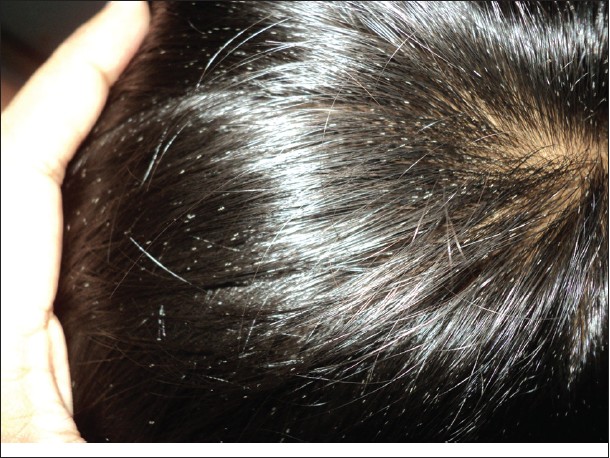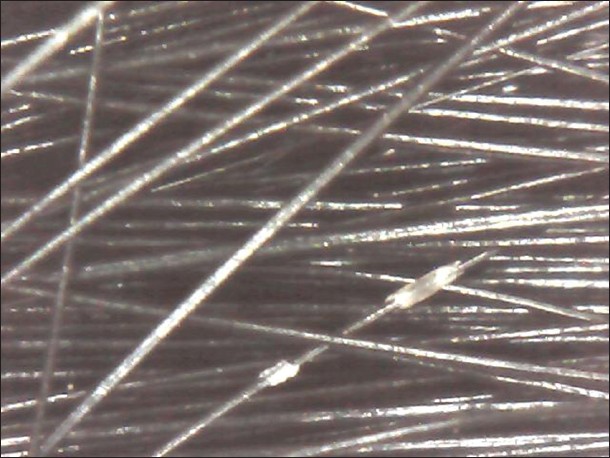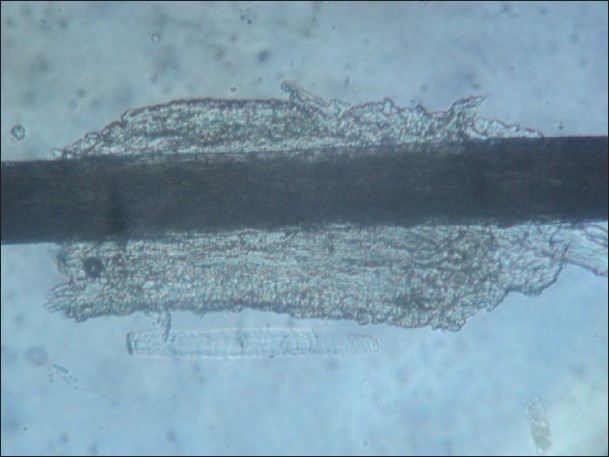Translate this page into:
Hair casts
Correspondence Address:
Satyaki Ganguly
Department of Dermatology, Venereology and Leprosy, Pondicherry Institute of Medical Sciences, Puducherry - 605 014
India
| How to cite this article: Ganguly S, Kuruvila S. Hair casts. Indian J Dermatol Venereol Leprol 2014;80:97 |
Sir,
A 5-year-old girl presented to the dermatology out-patient department with the complaints of asymptomatic whitish granules on the hair shafts for the past 2 months. There was no history of similar complaints in the family or friends. On examination, the granules were widespread over the scalp and could be moved along the length of the hair shafts [Figure - 1]. There was no hair loss and scalp was normal. On dermoscopy, whitish colored elongated tubular structures were seen encircling the hair shafts [Figure - 2]. The structures were present at varying distances from the scalp surface, sometimes multiple around a single hair shaft. On microscopy of few affected hair, irregular elongated concretions were seen around the hair shafts. A 10% potassium hydroxide preparation of the hair showed an irregular amorphous concretion around a normal hair shaft without any hyphae [Figure - 3] and the concretion dissolved with passage of time. Fungal culture in Sabourauds′s dextrose agar failed to reveal any fungal growth. Based on the above findings, a diagnosis of hair casts was made and the patient was prescribed a salicylic acid shampoo, but she was lost to follow-up.
 |
| Figure 1: Hair casts encircling the hair shafts |
 |
| Figure 2: Dermoscopic appearance of the hair casts: whitish coloured elongated tubular structures were seen encircling the hair shafts |
 |
| Figure 3: KOH preparation showing hair casts (×10) |
Hair casts are described as fine white amorphous keratinous cylindrical structures of variable sizes and number that encircle the hair shaft at varying intervals from the scalp surface. [1] It is hypothesized to be due to extension of the root sheath covering beyond the limits of the hair follicle. [2] Hair casts, also known as pseudonits, can be moved freely along the length of the hair shaft. This feature helps to differentiate it from conditions such as nits of pediculosis capitis, piedra, trichomycosis and trichorrhexis nodosa. [1],[3],[4],[5] In addition, hair microscopy is diagnostic for nits and trichorrhexis nodosa. A negative KOH examination and fungal culture ruled out piedra. Hair casts are made of keratin, therefore they dissolve in KOH preparation after some time. This is an idiopathic condition, although associations with psoriasis, seborrheic dermatitis, lichen simplex, lichen spinulosus, braiding and following use of hair lacquer/hair spray have been described. [2],[3] Propionibacterium acnes has been proposed as a causative agent of hair casts. [4] Solutions containing keratolytic agents such as salicylic acid and retinoic acid have given good results. [5] Hair casts are rarely reported, but form an important differential diagnosis for more common conditions. Dermoscopic appearance and gradual disappearance of the hair cast in KOH preparation can be an important clue for the diagnosis of this rare condition.
| 1. |
Thappa DM, Kumar V, Sharma RC, Lal S. Hair casts. Indian J Dermatol Venereol Leprol 1993;59:201-2.
[Google Scholar]
|
| 2. |
Fabbri P, Difonzo EM, Palleschi GM, Pacini P. Hair casts. Int J Dermatol 1988;27:319-21.
[Google Scholar]
|
| 3. |
Scott MJ Jr, Roenigk HH Jr. Hair casts: Classification, staining characteristics, and differential diagnosis. J Am Acad Dermatol 1983;8:27-32.
[Google Scholar]
|
| 4. |
Wang E, Lee JS, Hee TH. Is Propionibacterium acnes associated with hair casts and alopecia? Int J Trichology 2012;4:93-7.
[Google Scholar]
|
| 5. |
Ruiz-Villaverde R, Galán-Gutierrez M. Hair casts (pseudonits). CMAJ 2013;185:E425.
[Google Scholar]
|
Fulltext Views
15,855
PDF downloads
4,116





